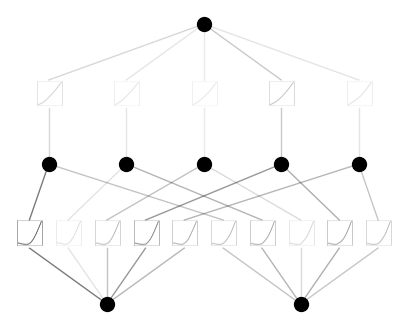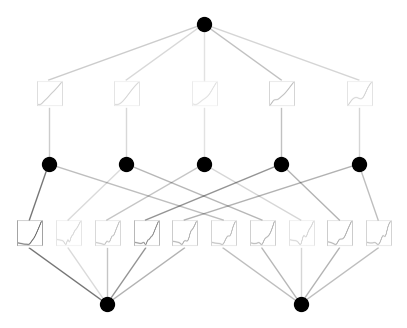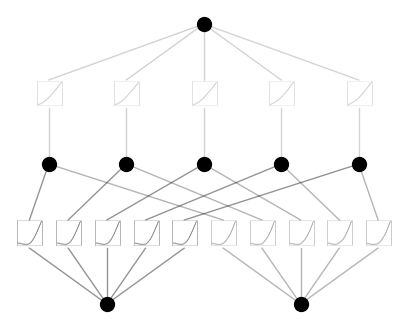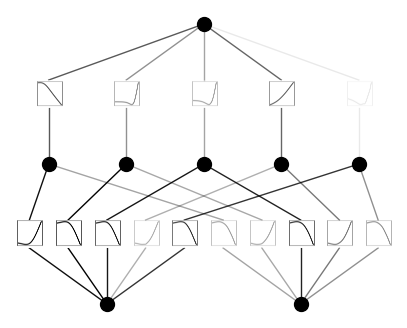Demo 5: Initialization Hyperparamters
Initialization is the first step to gaurantee good training. Each activation function is initialized to be \(\phi(x)={\rm scale\_base}*b(x) + {\rm scale\_sp}*{\rm spline}(x)\). 1. \(b(x)\) is the base function, default: silu, can be set with \({\rm base\_fun}\)
\({\rm scale\_base}=1/\sqrt{n_{\rm in}}+e\) where \(e\) is drawn from \(U[-{\rm noise\_scale\_base},{\rm noise\_scale\_base}]\). Default: \({\rm noise\_scale\_base}=0.1\).
\({\rm scale\_sp}=1\)
\({\rm spline}(x)\) is initialized by drawing coefficients independently from \(N(0,({\rm noise\_scale}/G)^2)\) where \(G\) is the grid number. Default: \({\rm noise\_scale}=0.1\).
Default setup
from kan import KAN, create_dataset
import torch
model = KAN(width=[2,5,1], grid=5, k=3, seed=0)
x = torch.normal(0,1,size=(100,2))
model(x) # forward is needed to collect activations for plotting
model.plot()

Case 1: Initialize all activation functions to be exactly linear. We need to set noise_scale_base = 0., base_fun = identity, noise_scale = 0.
model = KAN(width=[2,5,1], grid=5, k=3, seed=0, noise_scale_base = 0., base_fun = lambda x: x, noise_scale = 0.)
x = torch.normal(0,1,size=(100,2))
model(x) # forward is needed to collect activations for plotting
model.plot()

Case 2: Noisy spline initialization (not recommended, just for illustration). Set noise_scale to be a large number.
model = KAN(width=[2,5,1], grid=5, k=3, seed=0, noise_scale=1.)
x = torch.normal(0,1,size=(100,2))
model(x) # forward is needed to collect activations for plotting
model.plot()

model = KAN(width=[2,5,1], grid=5, k=3, seed=0, noise_scale=10.)
x = torch.normal(0,1,size=(100,2))
model(x) # forward is needed to collect activations for plotting
model.plot()

Case 3: Break Symmetry. When noise_scale_base is too small, nodes are almost degenerate. Sometimes we want to break such symmetry even at initialization. For an example, please see the PDE demo, where a non-zero noise_scale_base is important for achieving fast convergence.
model = KAN(width=[2,5,1], grid=5, k=3, seed=0, noise_scale_base=0.0)
x = torch.normal(0,1,size=(100,2))
model(x) # forward is needed to collect activations for plotting
model.plot()

model = KAN(width=[2,5,1], grid=5, k=3, seed=0, noise_scale_base=1.0)
x = torch.normal(0,1,size=(100,2))
model(x) # forward is needed to collect activations for plotting
model.plot()
